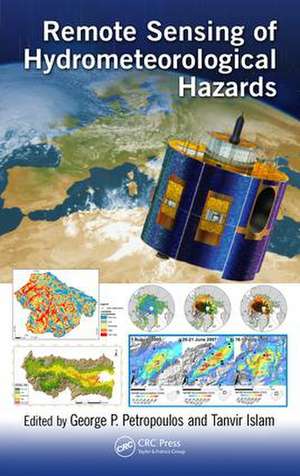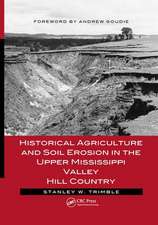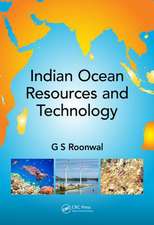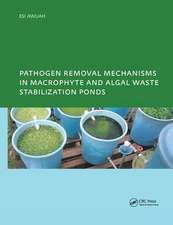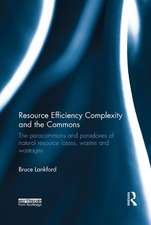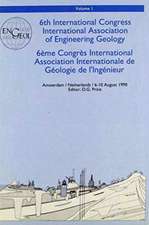Remote Sensing of Hydrometeorological Hazards
Editat de George P. Petropoulos, Tanvir Islamen Limba Engleză Hardback – 2 noi 2017
| Toate formatele și edițiile | Preț | Express |
|---|---|---|
| Paperback (1) | 324.28 lei 6-8 săpt. | |
| CRC Press – 30 iun 2020 | 324.28 lei 6-8 săpt. | |
| Hardback (1) | 1356.98 lei 6-8 săpt. | |
| CRC Press – 2 noi 2017 | 1356.98 lei 6-8 săpt. |
Preț: 1356.98 lei
Preț vechi: 1654.85 lei
-18% Nou
Puncte Express: 2035
Preț estimativ în valută:
259.69€ • 270.12$ • 214.39£
259.69€ • 270.12$ • 214.39£
Carte tipărită la comandă
Livrare economică 14-28 aprilie
Preluare comenzi: 021 569.72.76
Specificații
ISBN-13: 9781498777582
ISBN-10: 1498777589
Pagini: 549
Ilustrații: 100 Illustrations, color; 115 Illustrations, black and white
Dimensiuni: 178 x 254 x 30 mm
Greutate: 1.32 kg
Ediția:1
Editura: CRC Press
Colecția CRC Press
Locul publicării:Boca Raton, United States
ISBN-10: 1498777589
Pagini: 549
Ilustrații: 100 Illustrations, color; 115 Illustrations, black and white
Dimensiuni: 178 x 254 x 30 mm
Greutate: 1.32 kg
Ediția:1
Editura: CRC Press
Colecția CRC Press
Locul publicării:Boca Raton, United States
Public țintă
Academic and Professional Practice & DevelopmentCuprins
Section I: Remote Sensing of Drought 1. Drought and Remote Sensing: An Overview 2. Agricultural Drought Monitoring Using Satellite Soil Moisture and Other Remote Sensing Data over the Iberian Peninsula 3. Drought Assessments by Coupling Moderate Resolution Imaging Spectroradiometer Images and Weather Data: A Case Study in the Minas Gerais State, Brazil 4. The Added Value of Satellite Soil Moisture for Agricultural Index Insurance 5. Detecting the 2012 Drought in the Southeastern United States with Moderate Resolution Imaging Spectroradiometer- and Gravity Recovery and Climate Experiment-Based Drought Indicators Section II: Remote Sensing of Frost and Sea Ice Hazards 6. Frost and Remote Sensing: An Overview of Capabilities 7. Remote Sensing of Sea Ice Hazards: An Overview 8. Satellite Microwave Remote Sensing of Landscape Freeze–Thaw Status Related to Frost Hazard Monitoring 9. Temperature Fluctuation and Frost Risk Analysis on a Road Network by Coupling Remote Sensing Data, Thermal Mapping, and Geographic Information System Techniques Section III: Remote Sensing of Wildfires 10. Wildfires and Remote Sensing: An Overview 11. A Review on European Remote Sensing Activities in Wildland Fires Prevention 12. Remote Sensing of Fire Effects: A Review for Recent Advances in Burned Area and Burn Severity Mapping 13. Exploring the Relationships between Topographical Elements and Forest Fire Occurrences in Alberta, Canada 14. Quantifying the Interannual Variability of Wildfire Events across Portugal for the 2014–2015 Wildfires Using the Data from the European Forest Fire Information System Section IV: Remote Sensing of Flood 15. Satellite Remote Sensing of Floods for Disaster Response Assistance 16. Usefulness of Remotely Sensed Data for Extreme Flood Event Modeling: A Study Case from an Amazonian Floodplain 17. Large-Scale Flood Monitoring in Monsoon Asia for Global Disaster Risk Reduction Using MODIS/EOS Data 18. Introducing Flood Susceptibility Index Using Remote-Sensing Data and Geographic Information Systems: Empirical Analysis in Sperchios River Basin, Greece 19. Satellite-Based Precipitation for Modeling Floods: Current Status and Limitations Section V: Remote Sensing of Storms 20. Application of Remote-Sensing Images for Post-Wind Storm Damage Analysis 21. Analyzing Tropical Cyclones over India Using Precipitation Radar 22. Radar Rainfall Estimates for Debris-Flow Early Warning Systems: Effect of Different Correction Procedures on the Identification of Intensity–Duration Thresholds Section VI: Remote Sensing of Landslides 23. A Review of Unmanned Aerial Vehicles, Citizen Science, and Interferometry Remote Sensing in Landslide Hazards: Applications in Transportation Routes and Mining Environments 24. Landslide Susceptibility Assessment Mapping: A Case Study in Central Greece
Notă biografică
Dr. George P. Petropoulos is an Associate Professor in Remote Sensing & GIS in the Department of Geography & Earth Sciences (DGES) at Aberystwyth University in Wales, UK. He completed his graduate studies (MSc, PhD) at the University of London. Dr. Petropoulos’ research focuses on exploiting EO data alone or synergistically with land surface process models for computing key state variables of the Earth's energy and water budget, including energy fluxes and soil surface moisture. He is also conducting research on the application of remote sensing technology to land cover mapping and its changes occurred from either anthropogenic activities or geohazards (mainly floods, wildfires, frost). Dr. Petropoulos serves as a Council member and Trustee of the Remote Sensing & Photogrammetric Society (RSPSoC), he is Associate Editor and Editorial Board Member on several international peer-reviewed scientific journals in EO and environmental modelling. He has also convened the organisation of several scientific specialised sessions at international conferences. He is Editor/co-editor of 3 other books and co-author +55 peer-reviewed journal articles. He has developed fruitful collaborations with key scientists in his area of specialisation globally, and his research work so far has received international recognition via several noteworthy awards he has obtained.
Tanvir Islam is with the NASA Jet Propulsion Laboratory and specializes in remote sensing observations. Presently, he is engaged with the development of advanced microwave calibration and retrieval algorithms for NASA’s Earth observing missions. Prior to joining NASA/JPL in 2015, he was with the NOAA/ NESDIS/STAR and worked on the development of satellite remote sensing algorithms, with an emphasis on microwave variational inversion techniques (2013–2015). He also held visiting scientist positions at the University of Tokyo, Japan as part of the NASA/ JAXA precipitation measurement missions (PMM) algorithm development team, in 2012 and at the University of Calgary, Alberta, Canada in 2015. He earned his PhD in remote sensing at the University of Bristol, Bristol, United Kingdom in 2012.
Tanvir Islam is with the NASA Jet Propulsion Laboratory and specializes in remote sensing observations. Presently, he is engaged with the development of advanced microwave calibration and retrieval algorithms for NASA’s Earth observing missions. Prior to joining NASA/JPL in 2015, he was with the NOAA/ NESDIS/STAR and worked on the development of satellite remote sensing algorithms, with an emphasis on microwave variational inversion techniques (2013–2015). He also held visiting scientist positions at the University of Tokyo, Japan as part of the NASA/ JAXA precipitation measurement missions (PMM) algorithm development team, in 2012 and at the University of Calgary, Alberta, Canada in 2015. He earned his PhD in remote sensing at the University of Bristol, Bristol, United Kingdom in 2012.
Recenzii
"Remote Sensing of Hydrometeorological Hazards contains comprehensive reviews and case studies of the application of remote sensing for hazards assessment, including drought, frost and ice, wildfire, floods, hurricanes, and landslides. As a thorough review of the state-of-the-art in a wide range of applications, written by respected experts in the field, the book will be a useful reference for individuals involved with both research and application."
— Trent Biggs, San Diego State University, California, USA
"This book addresses all of the major hazardous events that can significantly affect human lives, the natural resources we depend upon, and the way we grow our food. The newly developed methods described here, employing the recent advances of technology and availability of Earth Observation data, provide information of higher quality and quantity, usable by the authorities as well as individuals. It is a much-needed review of Earth Observation methods and possibilities, recording the current level of remote sensing services available and a great asset for new scientists."
—Chariton Kalaitzidis, Mediterranean Agronomic Institute of Chania, Crete, Greece
"… a great contribution to the field remote sensing and hydrometeorological hazards. In my opinion, reading this very interesting book, which has six sections covering both theory and novel applications of remote sensing and GIS, is a must for everyone in the field of geosciences. What makes this book very interesting and special is that it represents decades of research conducted by leading scientists in the field. This book provides readers an all-inclusive critical overview about Remote Sensing of Drought, Frost and Sea Ice Hazards, Wildfires, Flood, Hurricanes and Landslides. I recommend this highly respected book for students, researchers, lecturers, decision makers and practitioners who would like to learn and update effectively their knowledge from top scientists."
—Salim
— Trent Biggs, San Diego State University, California, USA
"This book addresses all of the major hazardous events that can significantly affect human lives, the natural resources we depend upon, and the way we grow our food. The newly developed methods described here, employing the recent advances of technology and availability of Earth Observation data, provide information of higher quality and quantity, usable by the authorities as well as individuals. It is a much-needed review of Earth Observation methods and possibilities, recording the current level of remote sensing services available and a great asset for new scientists."
—Chariton Kalaitzidis, Mediterranean Agronomic Institute of Chania, Crete, Greece
"… a great contribution to the field remote sensing and hydrometeorological hazards. In my opinion, reading this very interesting book, which has six sections covering both theory and novel applications of remote sensing and GIS, is a must for everyone in the field of geosciences. What makes this book very interesting and special is that it represents decades of research conducted by leading scientists in the field. This book provides readers an all-inclusive critical overview about Remote Sensing of Drought, Frost and Sea Ice Hazards, Wildfires, Flood, Hurricanes and Landslides. I recommend this highly respected book for students, researchers, lecturers, decision makers and practitioners who would like to learn and update effectively their knowledge from top scientists."
—Salim
Descriere
This book focuses on drought, flood, frost, landslides, and storms/cyclones and will cover different applications of EO data used from prediction to mapping damages for each category. It will explain the added value of EO technology in comparison with conventional techniques applied today through many case studies.
